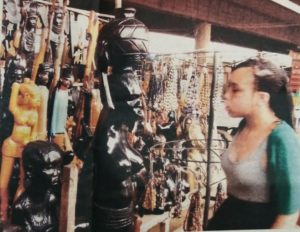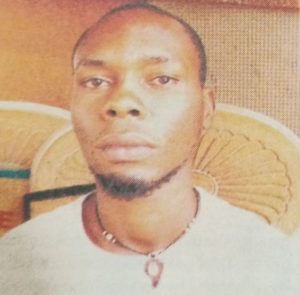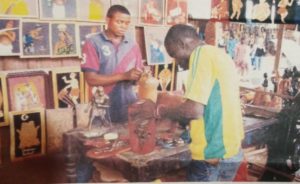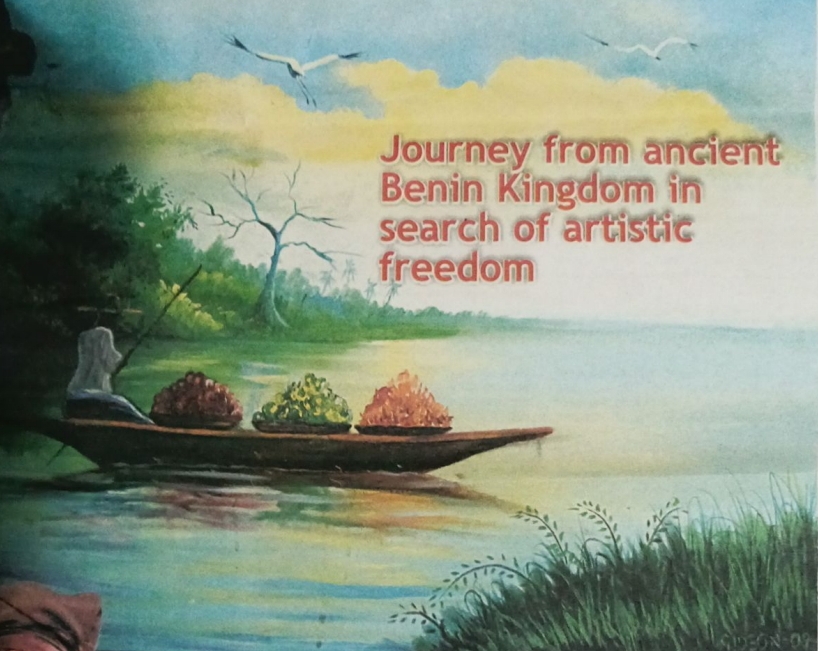Freedom of art would sound odd today but not in the ancient Benin kingdom where the artist needed permission from the Oba to practice, Osareti tells Osa Mbonu-Amadi in this encounter that took place 15 years ago and was first published by TCI Magazine in November 2009.
Welcome to Cane Village, Maryland, the National headquarters of Cane Weavers Association of Nigeria. But for the engine sounds of vehicles passing nearby and the vibrations of others passing atop the overhead bridge, the Cane Village is as peaceful as the works of art on display and under creation. . Just as one finds Hausas in majority at most ram or cattle markets and Igbos dominate the electronic market at Alaba, Benin and Edo people predominantly occupy this art and craft community known as Cane Village, Maryland. Besides cane furniture stands, there are three art workshops in the village. One of the shops belongs to a young man, Obasohan Osaretin, a painter and sculptor. His works on display are mixtures of sculptured images and paintings, but there are also different sizes and qualities of foot mats for cars and homes made of coconut fibers.

Osaretin says the foot mats, as simple as they appear, are all imported from India, United Kingdom or Korea, and each costs about N8, 000 or NI0, 000. According to him, a certain Indian man was using the coconut fibers in Badagry to weave foot mats but since the Indian returned to his country, the coconut fibers in Badagry have been wasting and Nigeria has been importing foot mats and brushes made of such Osaretin’s artistic history runs down his ancestral roots and is as remarkable as the product of his creative endeavour. His father, Obasohan, from Isiemwenro, was also a carver and sculptor. In those days, art was a closely ‘guarded trade and people could not practice it as freely as they did today.
There was an officially recognised family of carvers from Igbasama, who used their arts to serve the king, Oba of Benin. The artists who worked with brass came from Igun. All those people jealously guarded their arts and did not allow artists outside their clan to carve or sculpt. But Obasohan was highly gifted and gaining wide patronage. Around 1926 they reported him to the Oba, | saying he was practicing the art – without: belonging to their family. – The Oba therefore summoned Obasohan and ordered him to cease from carving.
During the colonial era when white men came, Obasohan took his case to the District Officer. After his visit to the District Officer, one of the Oba’s loyalists and messengers of the white man present during Obasohan’s visit to the D.O went to the Oba and told him about the visit. The Oba summoned Obasohan again and made him swear not to carve or sculpt again even with the permission of the District Officer. That sealed his carving career.
Ohasohan’s son, Osaretin, was only a lad when he heard this story concerning the frustration of his father’s talent as an artist and decided to carry on from where his. father had stopped. Today, that dream has been fulfilled. The various works of art in different mediums capturing local scenes and radiating peace are all evidences to the realisation of that dream. His workshop which doubles as showroom at the UTurn under the Maryland Bridge at the Ojota end is called. Edo Art Centre. Most prominent in Edo Art Centre. is the work Oseretin calls different faces of mask. It is tall, black, and actually has many faces. It is the kind of art works one sees in the lounges and receptions of big hotels, banks, airports, and even in homes of some people who know the value of artworks.

The biggest among these different faces of masks costs about N35, 000. Another abstract one sells for N40, 000, while an average 2 feet by 3 feet oil painting on canvas costs about N5 000 with frame.
Osaretin makes sales everyday. “God always brings people who come to by my works. I am happy with the money I make from my arts everyday,” he says. Osaretin
emphasises God in everything he | does. There is the invisible hand of God in his work. Few meters away from Edo Art Centre, sat two other young men from Delta, Isaac Akpofure and ThankGod Ibrirhe, weaving wonderful furniture just from canes. their products range from sitting room chairs of different designs, to beach settees, dinning sets, different baskets for storing clothing items, mirror frames, cupboards, room dividers, baby cots as well as cane beds for adults. A set of eight cane seats weaved in upholstered design goes between N80 000 and N90 000. Apart from their aesthetic beauties, they are less cumbersome and lighter to move about. Isaac reveals that the canes they use in weaving furniture are brought in from Edo and Delta, because the canes in Lagos forests and other nearby places are not as matured and good as those that come from Edo and Delta. The soft speaking artist, lsaac, also goes to the Atunda Olu School for . the mentally and physically handicapped, Surulere Lagos, to teach craft every Monday and Wednesday.

A walk on the Cane Village is in itself a tourism trip. On the far end of the village, a shallow stream flows across and a canoe paddled by a man shuttles between the two sides of the village separated by the stream. Those who need to go to the other side use the canoe. In all, the peaceful scenes depicted on the painting seem to sip into the environment and into the visitors despite the surrounding noise, The beautiful Delta and Edo songs sang by the women artists there as they weaved are equally soothing to the mind. The Maryland Cane Village is truly an unexplored goldmine on account of the human skills and peculiarity of the environment. It is a tourism and art centre waiting for investors.


